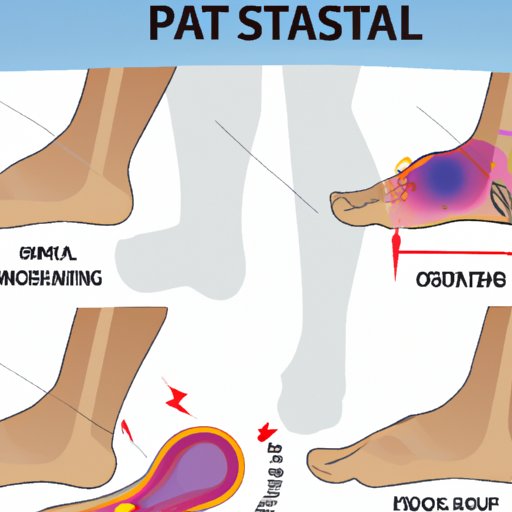
I. Introduction
Plantar fasciitis is a common foot condition that can cause a lot of pain and discomfort. It is important to understand its causes and how to prevent it to reduce your risk. By taking preventative measures and recognizing early symptoms, you can help protect yourself from developing plantar fasciitis.
II. What is Plantar Fasciitis?
Plantar fasciitis is a foot condition that affects the plantar fascia, a strong ligament that stretches from your heel to your toes. When this ligament becomes inflamed or strained, it can cause a severe pain in the bottom of your foot and the heel area. This pain is usually most noticeable after long periods of rest or inactivity. Common symptoms include a stabbing or shooting pain in the heel or arch of the foot, stiffness, and difficulty walking or standing after long periods of time.
III. Causes of Plantar Fasciitis
There are many risk factors that can cause plantar fasciitis, including age, weight, foot structure, and activity level. As we age, the plantar fascia can become less flexible and more susceptible to tearing and inflammation. Additionally, being overweight or having a high body mass index (BMI) can put extra stress on the ligaments and muscles in our feet, leading to inflammation and pain. People with flat feet or high arches are also at an increased risk of developing plantar fasciitis, as these conditions can put uneven pressure on the feet, leading to strain and ligament damage. Finally, certain activities like running, dance, or standing for long periods of time can also increase your risk.
IV. Footwear and Plantar Fasciitis
The shoes you wear can make a significant difference in preventing plantar fasciitis. Certain types of shoes, like high heels and flip-flops, can put extra stress on the ligaments and muscles in your feet. It is recommended to select supportive footwear with good arch support that cushions your feet and distributes pressure evenly. It’s also essential to note that people with flat feet or high arches have specific footwear requirements.
V. Activities and Behaviors that Contribute to Plantar Fasciitis
Repetitive stress on the feet can increase the risk of developing plantar fasciitis. Activities that require long periods of standing or walking, like retail jobs or factory work, as well as performing exercises like running and dancing, can put a lot of stress on your feet and lead to damage to the ligaments. It is essential to take breaks when you’re on your feet for an extended period. Additionally, anyone embarking on a new workout routine must ease into it gradually, allowing their feet and legs time to adapt to the increase in activity.
VI. Prevention of Plantar Fasciitis
Preventing plantar fasciitis is possible with some simple steps. Maintaining a healthy weight is important, given the excess weight puts pressure on your feet. Also, stretching regularly and wearing supportive shoes with adequate cushioning and arch support can help prevent the condition. Individuals with chronic foot problems or those who play sports should consult a physician or coach about ways to minimize their risk of developing plantar fasciitis through exercise and shoes.
VII. Treatment Options for Plantar Fasciitis
If you are experiencing early symptoms of plantar fasciitis, promptly consulting a podiatrist or foot doctor is essential. Some remedies for mild to moderate plantar fasciitis include rest, ice, stretching exercises, and physical therapy. NSAIDs can also help reduce inflammation. In more severe cases, custom orthotics, such as the ones prescribed by a podiatrist, can address the patient’s foot structure’s specific needs and support the proper alignment.
VIII. Conclusion
Plantar fasciitis is a painful and debilitating condition that can disrupt your life. While causes can vary, taking simple preventative measures like selecting supportive shoes, maintaining a healthy weight, and stretching daily can help keep your feet healthy. If you do happen to develop plantar fasciitis, prompt medical attention and treatment can help reduce inflammation and prevent further damage. By understanding the causes and taking preventative measures, you can avoid a lot of pain and discomfort in the future.




